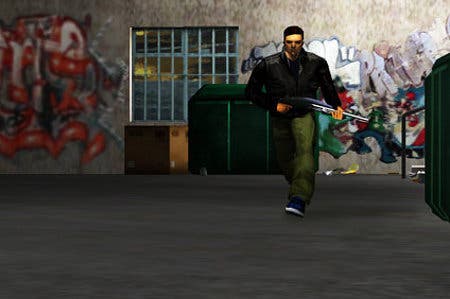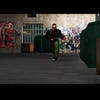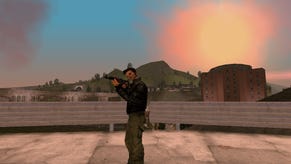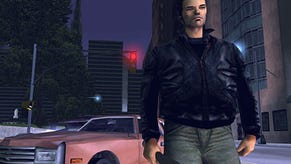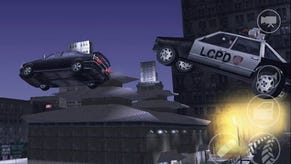Grand Theft Auto 3: 10 Year Anniversary Edition Review
Small time criminals.
"Have they pulled it off?" That was the question spitting incredulously from our lips back in 2001 when Grand Theft Auto made its leap from top-down 2D distraction to fully 3D, open-world game-changer. In a moment of cultural symmetry that probably means something or other, "have they pulled it off?" is also the question that greets GTA3 in 2011, as it celebrates its 10th birthday by debuting on mobile platforms that don't even have buttons.
It's a blue-plaque moment as far as technological change is concerned, and even though games like Infinity Blade should have convinced us that these pocket-sized devices can offer more than Snake and Minefield, the arrival of Grand Theft Auto on the iPhone is momentous enough to warrant a contemplative pause.
Given the ubiquity of so many of its ideas, it's easy to forget just what a paradigm shift Rockstar's opus represented. There had been open-world games before, of course, and Driver had already offered free-roaming car chase thrills only a few years earlier. What GTA did, in its leap to three fully fleshed-out dimensions, was expand the canvas. It wasn't just the freedom of movement, but the sense of place. The radio stations. The characters. The sly sense of humour. To be told we were at liberty to go nuts in Liberty City was a pivotal moment in the evolution of game design.
That's a lot of history, not to mention a lot of game, to cram into a platform smaller than the Dual Shock joypads used to play the original. So, have they pulled it off? Amazingly, the answer is yes. And no.
The good news is that Liberty City has made the transition intact. This isn't some cut-down rehash bearing the same title but offering limited pleasures. This is the full game, exactly as it was 10 years ago, faithfully carried across an ocean measured in years and evolving hardware.
Held in the palm of your hand, it's a fairly remarkable sight with one foot undeniably in the past - the angular faces, a frame rate that wobbles when things get busy, the buildings that pop into life in front of you - and the other in the future, as you realise that a game which once set the benchmark for cutting-edge games technology is now on your phone.
Even the audio, usually the first thing to be hacked away by developers keeping an eye on file sizes, has been retained. Every radio station, every skit, every politically incorrect cut-scene: it's all here and as fun as it ever was.
When even the most basic iPhone can pack several times more data than a DVD into its slender chassis, it was never really a question of how much of the game would survive the transition, but how it would play on a touch screen. Here, sadly, the good news dries up.
To be fair, GTA's mobile incarnation goes out of its way to offer a variety of control methods, but none are particularly successful. There's just no getting away from the fact that this is a game that was designed around controllers with multiple buttons, each of which was capable of being used for different commands in different contexts. The iPhone has a small screen, and that's it. As a result, crunching all the controls required into such a small space results in a distracting cascade of semi-transparent buttons down the side of the screen.
Driving fares marginally better than on-foot exploration, as it only requires an accelerator, brake, left and right steering and a button for getting in and out of vehicles. Shooting while driving is a fiddle too far, but it wasn't particularly well implemented in the original game either. You can opt to use free-form finger swipes for steering, as well as the accelerometer, rather than static left and right buttons, but this proves to be more fussy than workable. Finger swipes also move the camera left and right, while pressing the centre of the screen gives you a look behind. Of course, doing this means taking your fingers off the other controls, usually leading to a horrible crash.
It's while romping around on foot that the controls really struggle. Holding down a "walk" button means that wherever your other thumb lands becomes a virtual joystick. This flexibility is a nice touch but it can't compensate for what is, at best, a very flaky way of navigating a complex 3D world. Shooting is perhaps the only area to be significantly changed by the hardware - you now just tap the attack button while the game decides who to auto-target. It's clumsy and, more often than not, woefully ineffective.
As if sensing that there's no single right answer to solving the open-world control problem, the options menu offers commendable freedom to assign the controls in a way that feels natural. Icons can be resized and relocated, everything can be flipped for left-handed players, and there's a selection of different input methods to try. Even then, with so many functions to cram into such limited space, it's too easy to misplace fingers, hit the wrong hotspots and generally lose track of what goes where.
With practice and experimentation, it's possible to reach a compromise with the game that makes basic navigation just about feasible, assuming you don't mind bouncing off a few walls or jogging in circles every now and then. And this is fine, at least for those initial moments of nostalgic wonder as you romp about Liberty City, marvelling at the fact it's right there in the palm of your hand: a tiny window back to a fond memory.
Try actually playing the game - undertaking missions, evading police cars, surviving shoot-outs - and it's just not up to the job. It certainly doesn't help that crisp control was never GTA's strong suit, and that the mission structure in these experimental first steps into open-world design was already an exercise in frustration.
Strict countdowns, shoot-outs and escort missions, in an environment that can quickly spiral into chaos, are simply too much for this partially successful control scheme to cope with. You can restart missions instantly - a rare nod to modern convenience - but if the game had you biting the controller in frustration a decade ago, it'll drive you to tears on a touch screen.
All of which leaves this anniversary offering as something of a pyrrhic victory. You can run GTA3 on your phone, but you can't really play it. You can run around and drive cars, but any attempt to do anything more nuanced only ends in frustration.
It's to Rockstar's credit that, even in such a compromised state, there's still fun to be had, although that fun relies a tad too heavily on your fondness for the past than the reality of what's in your hand. At just £2.99, it's just about playable enough to make it worth a download, if only to see how it looks. However, few would argue that this is the best way to experience a genuine classic.
